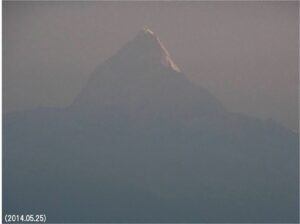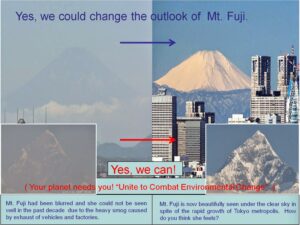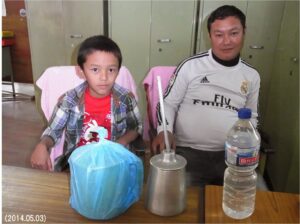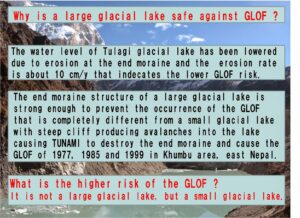ネパール2014春調査報告6 マチャプチャレ
最近のポカラはスモッグがひどく、ヒマラヤが良くは見えません(写真1)。豪雨と雹で空がきれいになるのですが、それでは農家の人が大変困ります。今はトウモロコシ(ネパール語でマッカイ)の成長期ですので、農家の人は適度のマッカイ コ パニ(トウモロコシ の 雨)を望んでいます(写真2)。ぼくのようなよそ者は豪雨と雹の激しい雨を、地元の農家の人はトウモロコシのためのやさしい雨を望みます。ポカラに居て、うまいこと両立しないのが最近の感想です。ただ、スモッグを減らし、大気汚染さえなければ、両立するような気がします。そこでぼくは、2008年からポカラの国際山岳博物館で学芸員をしましたので、その年の米国オバマ大統領のスローガン「Yes, we can.」をもじって、下記のような展示をおこないました。
さて、先日の氷河湖調査でお世話になったジャガート村のホテル、エコ・ホームの主人、チェ・バハドゥール・グルンさん(資料1)が子供さんを連れて、国際山岳博物館を訪ねてきてくれました(写真3)。子供さんのユケシュさんがポカラの寄宿学校にいるので、見舞いに来たのですが、ぼくには大好きなトンパ(発酵したヒエにお湯を注いでストローで飲む、日本酒の熱燗に似たお酒)とロクシ(自家製の焼酎)を持って来てくれました。聞くと、ジャガートの彼の村からポカラまでオートバイで約5時間かかって、ぼく用のお酒をリックに担いで来てくれたとのことです。彼は山岳博物館の展示見物はそこそこに、「息子には日本語を習わせて、日本に行ってほしい」とユケシュさんの前で言っていました。彼はそのことを息子さんに言うために博物館に来てくれたのではないか、と思えるほどでした。将来は、息子さんがネパールと日本の架け橋になってくれることを願うのみです。帰りに門まで送ると、タクシーの客引きがよってきて、「町まで300ルピー」というので、彼には、今日はお土産の酒も持って来てくれたので、500ルピー渡し、タクシーで帰ったらと言いましたが、彼は客引きと交渉した結果、300ルピーより安くならなかったので、「外で流しの安いタクシーを探す」といって、彼と息子は飄々として門を出て行きました。
資料1 2014年春ネパール調査(4) ツラギ
http://glacierworld.weebly.com/20142418026149124931249712540125233551926619412288124841252112462.html
ところで、来週はICIMOD(総合的山岳開発国際センター)の国際会議で、友人、BajracharyaさんやMoolさんから会議の詳しい内容が届き、参加者は発表内容の要旨を3月31日までに送ることになっていましたが、5月5日までに送れば、ポスター・セッションに参加できるように資料の事前手配をしてくれると言ってくれました。1か月以上も提出期限を無視する、いかにも、融通無碍のネパール流の好意がが感じられました。そこで両者の好意に甘えて、大急ぎで下記原稿を仕上げました。ぼくの話の内容は上記資料1と、前にお伝えした「なぜ、ネパールの大規模氷河湖は決壊しないのか」(資料2)で、“大きな氷河湖は比較的安全なので、自然破壊を伴う人工的な水路をを作るようなことはしないこと。氷河湖決壊洪水の危険性が高いのは小さな氷河湖であること” (写真4)を主張するつもりです。
資料2 なぜ、ネパールの大規模氷河湖は決壊しないのか
ネパール中央部マナスル地域のツラギ氷河湖の水位低下現象とGLOFリスク低減機構
http://glacierworld.weebly.com/112394123801228912493124971254012523123982282335215271692770327827282461239927770227301237512394123561239812363.html
記
Why is a large glacial lake safe against GLOF ( Glacial Lake Outburst Flood ) ?
1) Preface
Since 1970, I have been studying glaciers and glacial lakes in Nepal Himalayas and I found that many glaciers are receding and glacial lakes are expanding, and the Mingbo (Nare) GLOF occurred in 1977 when I had stayed in Khumbu (Fushimi et al,1985) . After that, we had experienced the Lagmoche (Digtso) GLOF in 1985 and the Saboi GLOF in 1999 in the Khumbu region and nearby. I must notice that all of them are smaller glacial lake which area is less than 1 km2.and no larger glacial lakes occurred the GLOF in the region.
2) Why is a large glacial lake safe against GLOF ?
The Tulagi glacial lake is located at the upper part of the Dana Khola, one of the Marshangdi’s tributary river in the west of Mt. Manaslu. The water level of Tulagi glacial lake has been lowered due to the outlet erosion at the end moraine and the erosion rate is about 10 cm/y since the 18th glacial advance that indicates to lower the GLOF risk. At the same time, the lake level continuously lowers in recent years since 1990’s. I noticed last fall that the same kind of the lowering lake level is occurring in the Imja glacial lake in Khumbu region.
The end moraine structure of a large glacial lake is strong enough to prevent the occurrence of the GLOF that is completely different from a small glacial lake with steep cliff at the upper part of the lake producing avalanches directly dropping into the lake causing TUNAMI to destroy the fragile ice-cored end moraine and cause the above GLOF in 1977 (Fushimi et al,1985), 1985 and 1999 in Khumbu area and nearby, east Nepal.
3) No man-made canal construction necessary for the larger glacial lake like the Tulagi
The United Nations Development Programme (UNDP) and Nepal made an agreement to implement the Community Based Flood and Glacial Lake Outburst Risk Reduction Project (CBFGLOF) to minimise threats of the Imja GLOF to nearly 100‚000 people (The Himalayan Times, 2013).
There is a possibility that one of the large glacial lake, the Imja, is also taking the same process which I observed in the Tulagi glacial lake, so we must study and make necessary field observations before making such kind of the big man-made project done in the Tso Rolpa glacial lake in the Rolwaline Himal. As the ICIMOD (2011) reported “Imja Tso has less likihood of outburst than Tulagi lake”, here I reported the Tulagi is safe agaist the GLOF, so I don’t know why the UNDP and Nepal government made such an above agreement to the more safer Imja glacial lake than the Tulagi. Such sort of man-made canal construction kills the valuable and prestine Himalayan nature, unless it is inevitable.
4) Conclusions and Recommendations
What is the higher risk of the GLOF ?; It is not a large glacial lake, but a small glacial lake. Relatively larger glacial lakes such as the Tulagi and the Imja are safe against GLOF, however we must be very careful about the small glacial lakes developing, for example, in the Hong Khola near Mt. Chamlang and it is needed the so called man-made treatment to prevent the GLOF to such small glacial lakes with steep cliff in the upper part of the accumulation area, but not to the large glacial lake.
5) References
1) Fushimi et al, 1985 Nepal case study: Catastrophic Flood. Techniques for prediction of runoff from glacierized areas, International Association of Hydrological Sciences, 149, 125-130.
2) The Himalayan Times 2013 Nepal, UNDP ink deal on cutting flood risk.
http://www.thehimalayantimes.com/fullNews.php?headline=Nepal%2C+UNDP+ink+deal+on+cutting+flood+risk+&NewsID=383913
3) ICIMOD 2011 Glacial Lakes and Glacial Lake Outburst Floods in Nepal. Kathmandu: ICIMOD.




